Turquoise is a beautiful blue-green stone that has captured the hearts of many. Here in our state, with its diverse landscapes and rich geological history, hunting for turquoise can be an exciting adventure.
This article will guide you to the best spots for finding turquoise in our state and share helpful tips to make your search successful.
So, let’s dive in and explore the best places where you can find Turquoise easily!
How Turquoise Forms Here
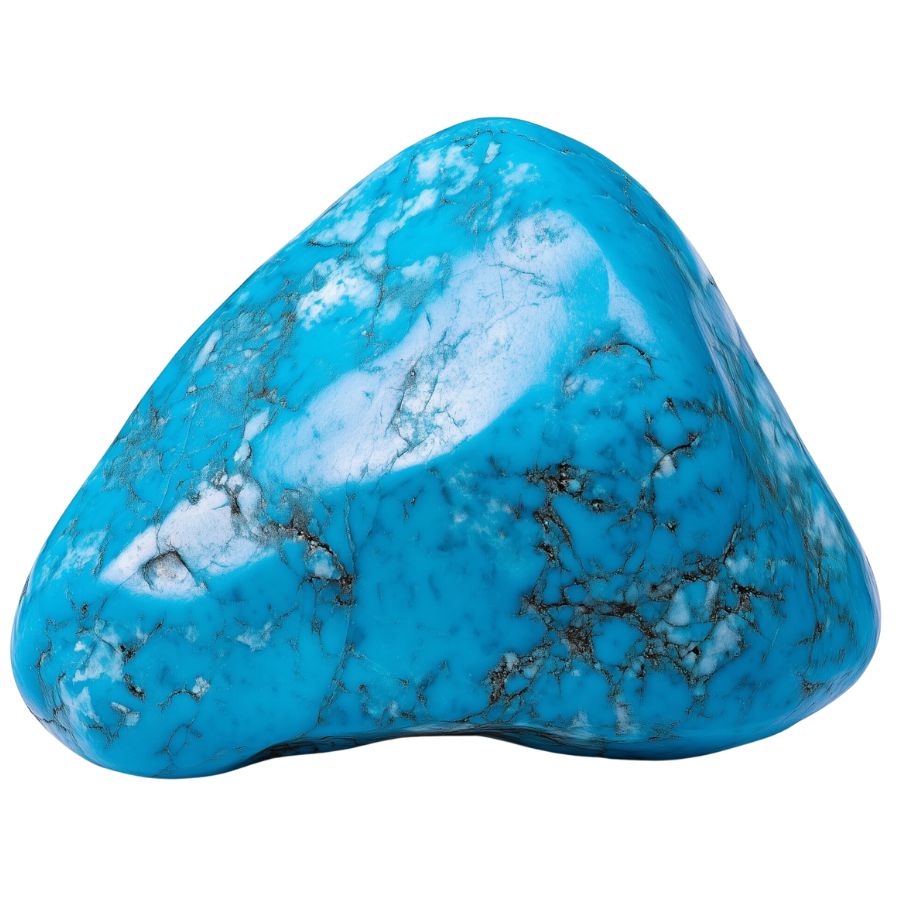
Turquoise forms through a unique process involving water and minerals. It begins when acidic water seeps into the ground, moving through rocks that contain copper and aluminum.
As this water interacts with these minerals, it breaks them down and allows the copper and aluminum to combine with phosphorus, creating turquoise.
This usually happens in shallow areas, often less than 20 meters deep, where the environmental conditions are just right.
This mineral typically fills cracks and cavities in rocks, often in dry, desert-like areas. The presence of iron can also influence its color, giving it beautiful shades of blue and green.
Over time, the turquoise hardens, resulting in the stunning gem we see today, prized for its vibrant hues and unique patterns.
The Types Of Turquoise Found in the US
Turquoise comes in a variety of stunning types, found in the US as well as in our state. Here are the types of turquoise found in the US:
Kingman Turquoise

Kingman Turquoise showcases a vibrant range of colors from pale green to deep “high blue.” Its matrix patterns can include white, light brown, or black veining, setting it apart from other turquoise types.
This stone is often stabilized to enhance its durability and color, allowing for broader use in jewelry making. The natural Kingman turquoise typically presents a medium blue hue with a water web matrix.
Kingman Turquoise is recognized as one of the most sought-after American turquoise. Its consistent supply has made it a staple in Native American jewelry and artisan crafts, contributing to its ongoing popularity.
Carico Lake Turquoise

Carico Lake Turquoise is known for its clear robin’s egg blue to vibrant lime green colors. It often features a unique spider-web matrix in brown or, more rarely, black, adding texture and shine to the stone.
What makes this stone special is its high zinc concentration, which gives it an electric lime-green hue. This color is both rare and desirable among turquoise varieties.
Gem-quality Carico Lake Turquoise is scarce, making up less than 3% of the mine’s annual output. This rarity, combined with its natural beauty, makes it a prized item for collectors and enthusiasts alike.
Lone Mountain Turquoise

Lone Mountain Turquoise is known for its bright blue to deep green colors, often featuring intricate spider web matrix patterns. These fine lines create a web-like design, enhancing its visual appeal.
This stone stands out for its exceptional hardness and color retention. It maintains its vibrant hue over time, a quality not common in all turquoise varieties.
Lone Mountain Turquoise is highly valued in the collector’s market, second only to Lander Blue Turquoise. Its ability to produce high-quality spider web turquoise makes it a favorite among jewelry artisans and collectors.
Morenci Turquoise
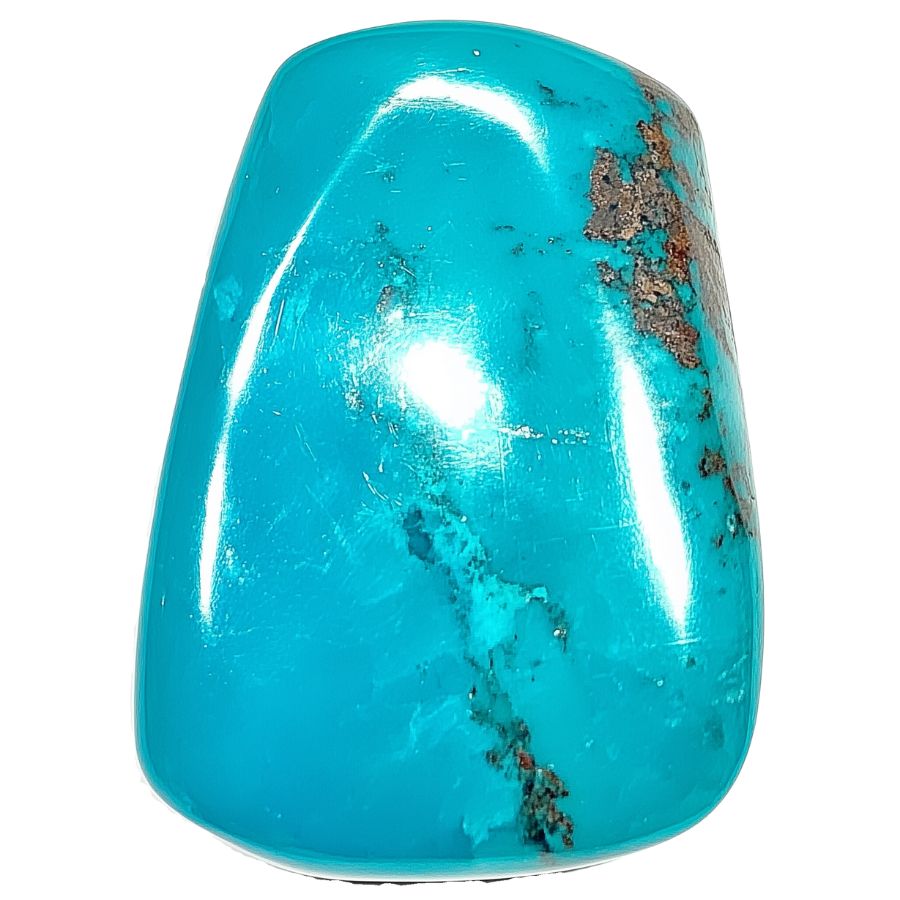
Morenci Turquoise stands out with its deep blue color, a result of its high copper content.
Its most striking feature is the iron pyrite matrix, which gives it a metallic shimmer when polished. Some pieces also show a water web matrix, creating dark blue webbing patterns.
This stone is no longer mined, making it rare and highly collectible. All available Morenci Turquoise comes from mining operations that stopped in 1984.
High-grade pieces, known for vibrant blues and pyrite matrix, make up less than 10% of the total yield.
Pilot Mountain Turquoise
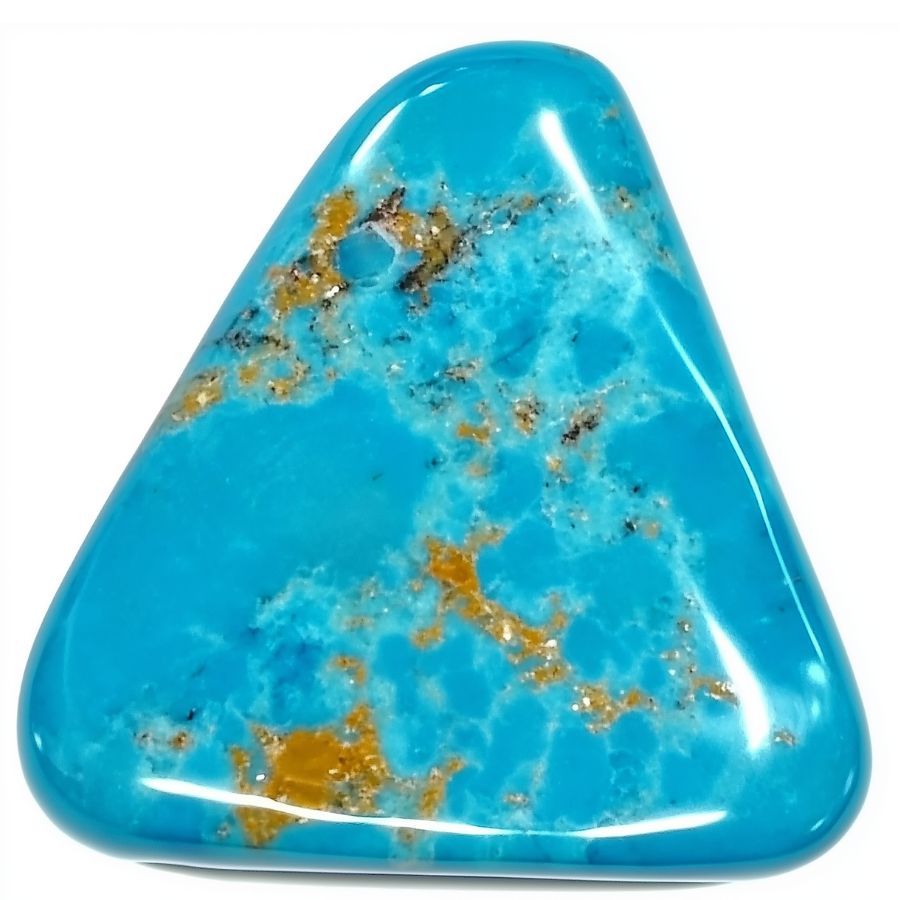
Pilot Mountain Turquoise catches the eye with its bright to dark blue hues, often showing a greenish tint.
What makes it special is its brownish-red limonite matrix, creating beautiful mottled patterns. The stone forms in hard veins, thin seams, or nuggets.
This turquoise has an interesting history, first mined around 1930. It’s known for its limited availability, with only 150 to 200 pounds of rough stone extracted twice a year. This scarcity adds to its appeal.
The unique mottled patterns of the limonite matrix make Pilot Mountain Turquoise a favorite for decorative pieces and jewelry.
Sleeping Beauty Turquoise

Sleeping Beauty Turquoise is famous for its vivid sky-blue color. Unlike many other turquoise types, it has little to no veining or matrix, giving it a pure, consistent look. The color can range from light robin’s egg blue to deeper sky blue.
This stone is naturally hard, which means it doesn’t need stabilization for use in jewelry. This quality makes it popular with jewelers. The Sleeping Beauty mine closed in 2012, making the stone rarer and more valuable.
Sleeping Beauty Turquoise became a hit in the 1970s and 80s, used in both Native American jewelry and mainstream fashion. Its consistent quality and vibrant color have made it a standard in Southwestern jewelry.
Bisbee Turquoise
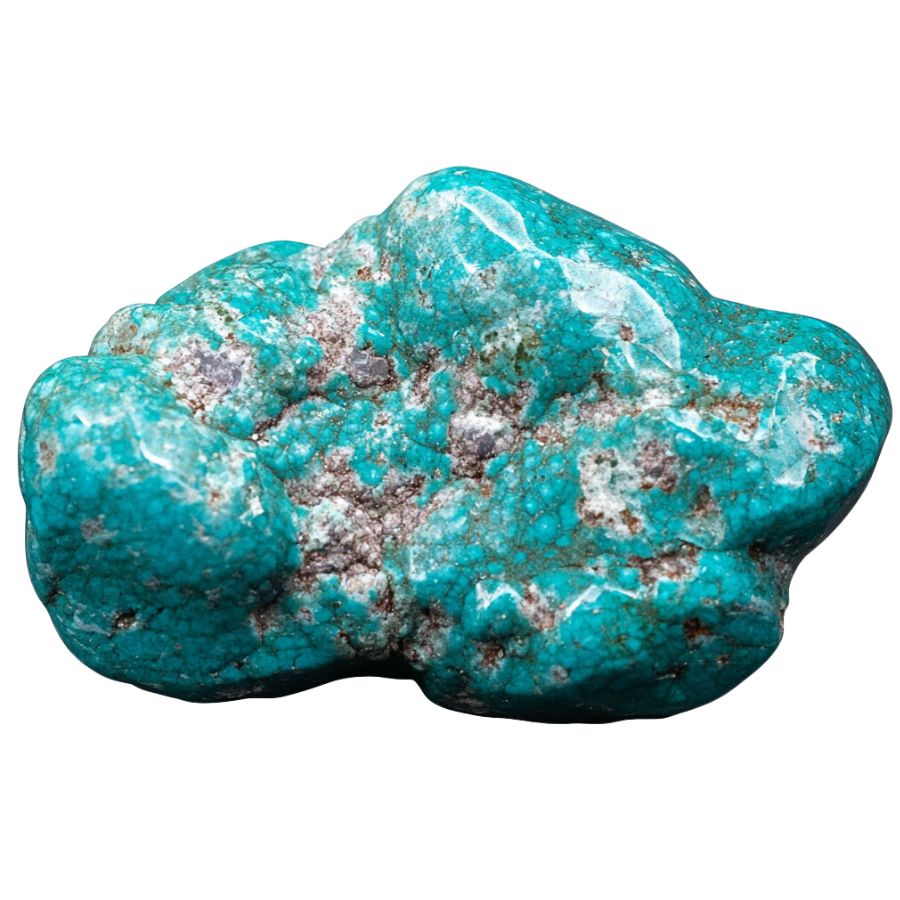
Bisbee Turquoise stands out with its vibrant blue shades, ranging from deep indigo to light robin’s egg blue. Green hues are less common but still occur.
Its distinctive matrix often displays a striking spiderweb pattern against a reddish-brown backdrop.
This stone’s unique appearance comes from its host rock color and gloss. Unlike some turquoise with metallic matrices, Bisbee’s matrix is typically more earthy and varied in color.
Bisbee Turquoise is highly valued for its quality and rarity. Its historical significance, being one of the oldest turquoise sources in North America, adds to its appeal among collectors and enthusiasts.
Royston Turquoise

Royston Turquoise is a gem of many faces. Its colors can shift dramatically, even within a single stone.
You might find a piece that starts as a soft blue and gradually transforms into a rich green. This color play is a hallmark of Royston Turquoise.
The stone’s matrix is equally fascinating. The matrix can create intricate landscapes within the turquoise, resembling golden sunsets or stormy skies.
Royston Turquoise is also known for its ability to take an exceptionally high polish. This quality, combined with its natural hardness, makes it a favorite for jewelry that can withstand daily wear.
Dry Creek Turquoise

Dry Creek Turquoise stands out with its pale pastel blue color, similar to Larimar. It often has light brown, golden yellow, or orange webbed matrices, adding to its beauty.
Unlike many turquoise types, it’s naturally hard and takes a stunning polish without treatment.
This stone is quite rare. It was discovered in the 1990s in an area with low levels of heavy metals. These metals usually give turquoise its bright colors. The unique geological setting results in Dry Creek’s captivating pale blue hue.
The natural hardness and ability to take a high polish make Dry Creek Turquoise special.
Ithaca Peak Turquoise

Ithaca Peak Turquoise is known for its stunning range of blues. It can be light blue with black spider-webbing or deep rich blue with black matrix.
Some pieces even have quartz matrix and pyrite inclusions. The most valued stones have vibrant to dark blues with good pyrite inclusions.
What makes this stone unique is its pyrite. In Ithaca Peak Turquoise, the pyrite often has a brassy color. This helps tell it apart from similar stones like Morenci turquoise.
Recently mined Ithaca Peak Turquoise looks different from older pieces. The new stones are lighter blue to green and usually don’t have a webbed matrix. This change in appearance over time adds to the stone’s interesting history.
What Raw Turquoise Looks Like
When you’re going to collect the raw turquoise, it’s important to know what to look for. Let’s talk about how you can identify genuine raw turquoise.
You only need to know a few things in order to find it, but having a guide will be very helpful.
DON'T MISS OUT ON ANY GREAT FINDS!
While you're out searching for Turquoise you're going to find A LOT of other interesting rocks and minerals along the way. The last thing you want to do is toss out something really interesting or valuable. It can be easy to misidentify things without a little guidance.
You absolutely need a good reference guide in order to understand what you're looking at!
We've put together a fantastic field guide that makes identifying 140 of the most interesting and valuable rocks and minerals you will find REALLY EASY. It's simple to use, really durable, and will allow you to identify just about any rock and mineral you come across. Make sure you bring it along on your hunt!
Now, back to the identification specifics:
Look for the Blue-Green Color

The color is the big clue. Rough turquoise is often blue or green, sometimes with hints of both.
The blue comes from copper, while the green hints at more iron or other minerals.
Real turquoise tends to have a more vibrant, consistent color. If it looks too perfect, like solid blue or green with no variations, be cautious. Nature isn’t that perfect!
Assess the Density and Weight
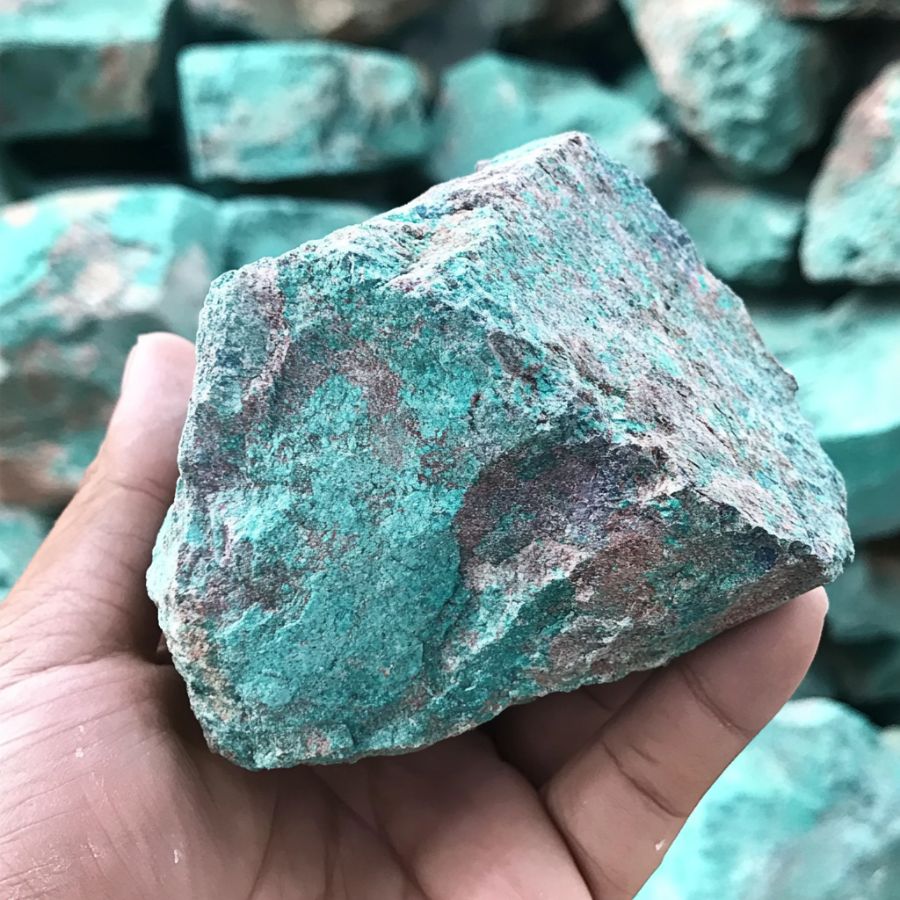
Pick up the stone and feel its weight. Real turquoise is pretty dense, so it feels heavier than it looks. If the stone feels too light, it might not be genuine.
Authentic turquoise has a specific gravity of about 2.5 to 2.9, making it heavier than many imitations.
The density comes from the minerals packed tightly together over millions of years. A heavier stone usually means a better-quality piece.
Check for a Glassy or Waxy Luster

Rough turquoise often has a glassy or waxy luster, not too shiny but not dull either. When you hold it up to the light, the surface might have a soft, smooth sheen. This luster is key.
A rough piece with a good luster usually indicates that it’s real turquoise and not a fake. You’ll notice that it reflects light in a muted way, not too bright.
Consider the Stone’s Shape and Texture

Rough turquoise isn’t always smooth. It often has a bumpy, uneven texture because it forms in cracks and crevices of other rocks.
The stone’s shape might be irregular or lumpy. This natural texture is a telltale sign that you’re holding real turquoise and not a polished or treated piece.
A Quick Request About Collecting
Always Confirm Access and Collection Rules!
Before heading out to any of the locations on our list you need to confirm access requirements and collection rules for both public and private locations directly with the location. We haven’t personally verified every location and the access requirements and collection rules often change without notice.
Many of the locations we mention will not allow collecting but are still great places for those who love to find beautiful rocks and minerals in the wild without keeping them. We also can’t guarantee you will find anything in these locations since they are constantly changing.
Always get updated information directly from the source ahead of time to ensure responsible rockhounding. If you want even more current options it’s always a good idea to contact local rock and mineral clubs and groups
Tips on where to look
Once you get to the places we have listed below there are some things you should keep in mind when you’re searching:
Riverbeds

Look for turquoise in riverbeds. Over time, water flow can expose hidden stones.
Sediment may hold the gems you’re after. Be prepared to dig through gravel and dirt to find them.
Abandoned Mines
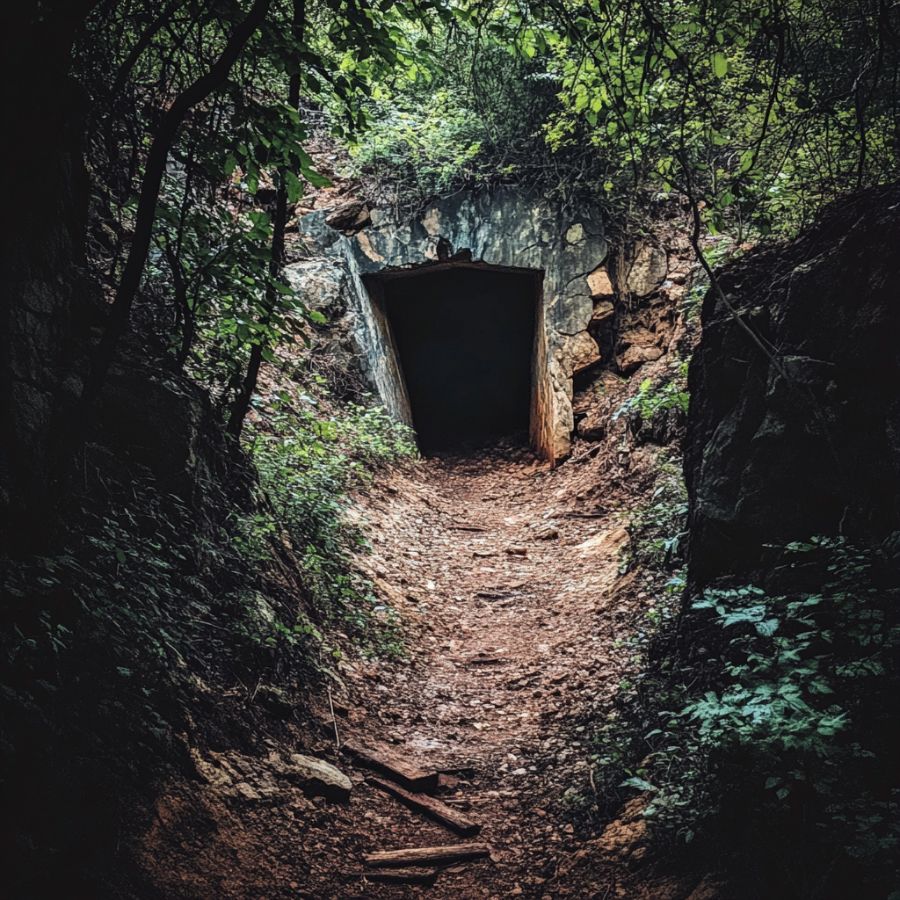
Old mines can be treasure troves for turquoise. These sites often have loose rocks where turquoise might be hiding.
Always be careful while exploring abandoned areas, though.
Hillsides

Check hillsides, especially where erosion is visible. Rain and wind can uncover layers of earth, exposing turquoise.
It’s a bit of a hunt, but it can be rewarding. Sometimes, you’ll find small stones just lying on the surface.
Rocky Outcrops

Rocky outcrops are great places to search. They are full of minerals and might have turquoise.
Explore the cracks and crevices. Turquoise often hides in these tight spaces.
The Types Of Turquoise Found In Arkansas
During your exploration to find turquoise in Arkansas, you have a chance to stumble upon the following vibrant rocks against our state’s earthy browns and grays:
- Mona Lisa turquoise
- Blue-green turquoise
- Greenish-blue turquoise
- Green turquoise
The Best Places To Find Turquoise in Arkansas
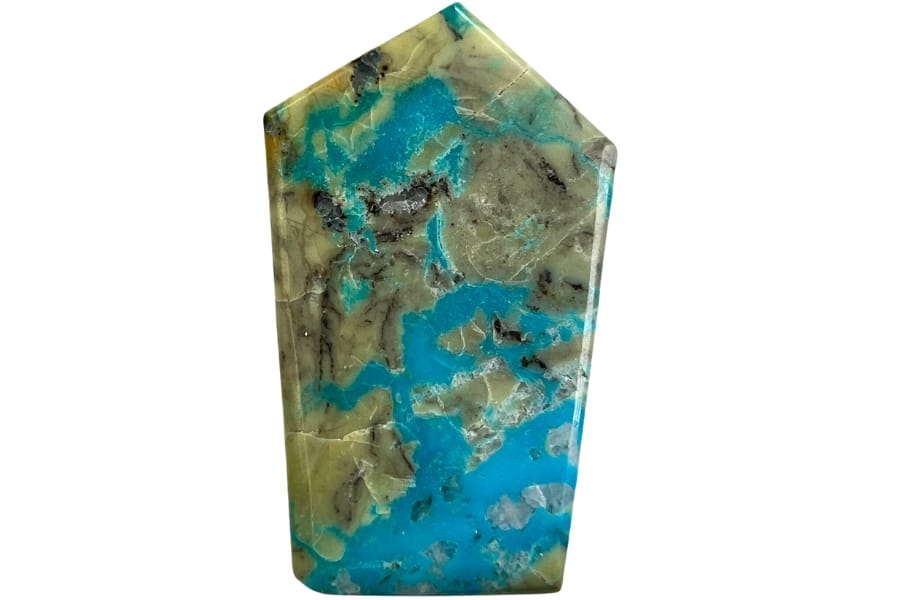
As you might already know, our state is not one to easily run out of places that you can visit and explore. There are many gem mine sites in Arkansas, but very few of them have turquoise. If you want to know about these places, you’re in for a treat!
Always Confirm Access and Collection Rules!
Before heading out to any of the locations on our list you need to confirm access requirements and collection rules for both public and private locations directly with the location. We haven’t personally verified every location and the access requirements and collection rules often change without notice.
Many of the locations we mention will not allow collecting but are still great places for those who love to find beautiful rocks and minerals in the wild without keeping them. We also can’t guarantee you will find anything in these locations since they are constantly changing.
Always get updated information directly from the source ahead of time to ensure responsible rockhounding. If you want even more current options it’s always a good idea to contact local rock and mineral clubs and groups
Ouachita Mountains

The Ouachita Mountains stretch from east to west and are packed with winding rivers, deep forests, and big, clear skies. They’re not too tall but have lots of steep, rocky parts that are fun to explore.
What’s cool is that these mountains are over 300 million years old! They’re famous for their crystals, especially quartz. If you’re lucky, you might even find some turquoise! The rocks here have been squeezed and heated over millions of years, and that’s why there are so many different kinds to find.
If you want to visit, the Ouachita Mountains are easy to get to. They’re just west of Little Rock, which is the capital of Arkansas. You can drive there on Interstate 30 and head toward Hot Springs. From there, you can take scenic drives on highways 7, 9, and 10, which go right through the heart of the mountains.
Before you start exploring and searching for turquoise, make sure to check out Arkansas’ collecting guidelines.
Where we found turquoise in the Ouachita Mountains
There are reported sightings of minor quantities of turquoise in several sites within the Ouachita Mountains, so better check them out when you visit here.
DON'T MISS OUT ON ANY GREAT FINDS!
While you're out searching for Geodes you're going to find a lot of other interesting rocks and minerals along the way. The last thing you want to do is toss out something really interesting or valuable. It can be easy to misidentify things without a little guidance.
We've put together a fantastic field guide that makes identifying 140 of the most interesting and valuable rocks and minerals you will find REALLY EASY. It's simple to use, really durable, and will allow you to identify just about any rock and mineral you come across. Make sure you bring it along on your hunt!
Mona Lisa Turquoise Mine

Mona Lisa Turquoise Mine, tucked near the summit of Porter Mountain in Polk County, was actively mined from the mid-1970s until the early 1990s. The turquoise found here filled cracks in the local rock, called novaculite, and was known for its unique quality.
The terrain of Porter Mountain is rugged and wooded, offering a true back-to-nature experience. This place is endowed with turquoise veins nestled within the hard, siliceous novaculite.
Geologically, this mine is where the story of Arkansas turquoise unfolds. With its rich, beautiful powder-blue and blue-green turquoise, Mona Lisa Mine is a testament to the area’s fascinating mineralogical and geochemical narrative.
Where we found turquoise at the Mona Lisa Turquoise Mine
You can find Mona Lisa turquoise if you explore its nooks and crannies, particularly within thin veins in the mine, only a few millimeters thick.
Mauldin Mountain Quarries

Mauldin Mountain Quarries is known for producing various minerals since the 1970s. It’s located in Montgomery County, near the town of Mount Ida, which is known as the quartz crystal capital of the world.
The quarries are on the south side of Mauldin Mountain and are characterized by open cuts on the mountainside in the fractured Bigfork Chert. The mountain itself is part of the Ouachita Mountains.
To get here, you’d typically head to Mount Ida, which is accessible via Highway 270 if you’re coming from the east or west, or via Highway 27 if you’re traveling from the north or south. From Mount Ida, navigate towards Mauldin Mountain, which is located northwest of the town.
Where we found turquoise at Mauldin Mountain Quarries
Mauldin Mountain’s terrain can be quite rugged and forested, and though this may pose a challenge, it provides a true sense of adventure. Turquoise from this area can be found in the area deposits of the quarries.
Buckeye Mountain

Buckeye Mountain offers an extraordinary experience for rock hunters looking to explore and connect with nature. It’s nestled in the Caney Creek Wilderness near Mena, in the southeast.
The terrain here is a mix of tranquil forests and striking rock formations, particularly along the ridge line, which provides awesome photo opportunities.
For a challenging yet rewarding trek, the trail from Buckeye to Caney Creek spans over 11 miles, with various connecting trails that can transform the hike into a loop. Along the way, you can marvel at Katy Falls, a beautiful 12-foot waterfall towards the end of the trail.
If you want to visit, head to southeast Mena and embark on the trails that wind through the wilderness. Remember, it’s a pack-in-pack-out area, so you are encouraged to leave no trace to preserve the natural beauty of the region.
Where we found turquoise at the Buckeye Mountain
When you search through Buckeye Mountain, you can find thin veins of planerite, which is a mineral closely associated with turquoise because they occur in similar geological settings.
So when you see a thin vein of planerite, you might be close to a turquoise specimen!
Big Bear Mine

Nestled in the Ozark Mountains, the Big Bear Mine boasts a rich geology with a treasure trove of rocks and minerals. Its terrain is a mix of rocky hills and lush green forests, making it a scenic adventure for you.
The mine’s soil is a canvas of colors, thanks to the minerals below. Quartz crystals may be the stars here, but you can also find turquoise specimens if you’re keen enough to find them.
Getting to Big Bear Mine is a journey in itself. It’s located near Jessieville and is about a 30-minute drive north of Hot Springs. The drive is a beautiful one, with winding roads surrounded by towering trees and rolling hills.
Where we found turquoise at Big Bear Mine
The Big Bear Mine is situated in a geological setting where turquoise formation occurs, specifically at a shear zone where the Bigfork Chert meets the Womble Shale. If you want to find turquoise here, we highly suggest exploring these areas.
Other Great Places To Find Arkansas Turquoise
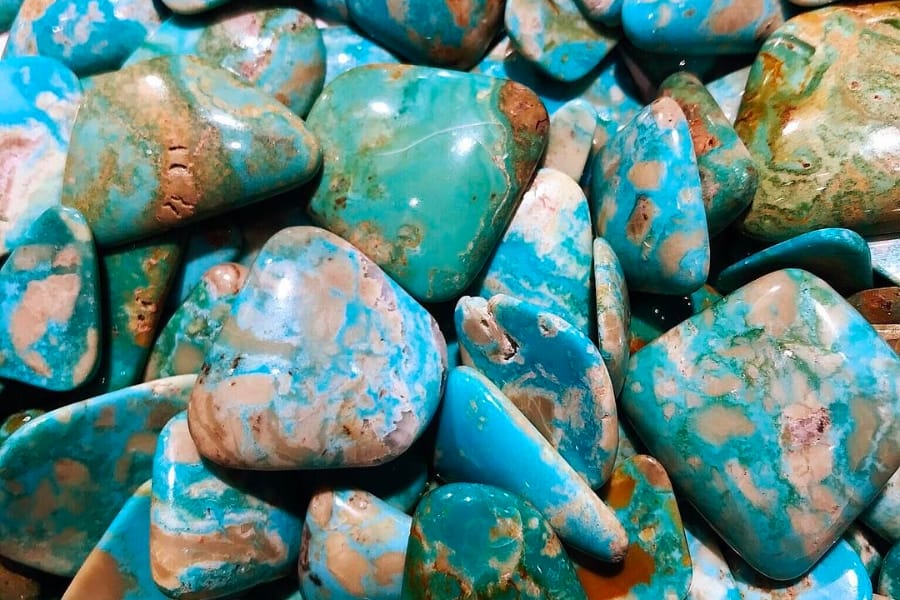
Aside from our top recommendations, here are more legit spots where you can find turquoise in Arkansas.
Our recommendations by county
| County | Location |
| Montgomery | North Mountain Mine |
| Polk | Coon Creek Mine |
| Polk | Isom Avants pits |
Common Turquoise-Hunting Questions
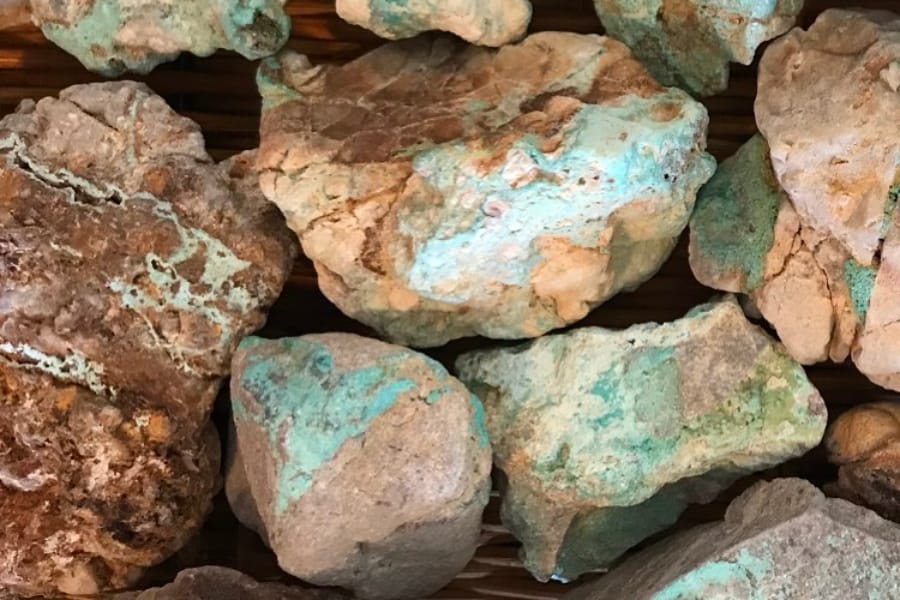
In this section, we’ll answer the most common question asked by those who have gone to Arkansas to find turquoise.
Is it illegal to collect turquoise in Arkansas?
The legality of collecting turquoise in Arkansas depends on the location and the intent behind the collection. Generally, a permit is required for collecting in bulk or for commercial purposes in national forest lands.
Also, if you plan to collect turquoise within a designated mining claim or private property, permission from the claim holder or the property owner is necessary. Furthermore, certain areas like state parks may have their own rules regarding this.
Before heading out here, it’s a good practice to research the area you plan to visit and visit the website of the Arkansas Department of Parks, Heritage, and Tourism for more information on collecting rules in that area.
The Best Places To Buy Turquoise In Arkansas

Finding turquoise in Arkansas, and practically anywhere, takes time, energy, and the willingness to be out in the wild. If you’re not up for it but still want to take home this gorgeous gem, you may want to visit our local rocks and minerals shop.
Here are some of our trusted ones:
- AHW Gems and Minerals – 10332 AR-265, Fayetteville, AR 72701
- Avant Mining Fisher Mountain Rock Shop – 11 Logan Gap Rd, Mt Ida, AR 71957
- Crystal Waters – 7 Spring St, Eureka Springs, AR 72632
- Fidler’s Ridge Rock Shop – 3752 Hwy 270 E, Mt Ida, AR 71957
- Gem Adventures Rock Shop – 107 W Emma Ave, Springdale, AR 72764


